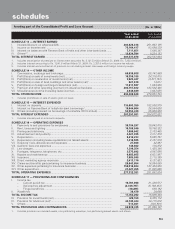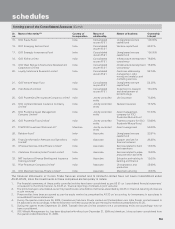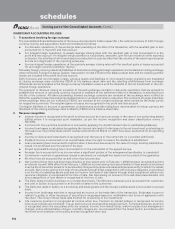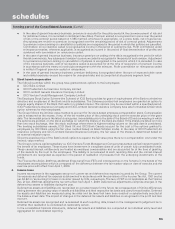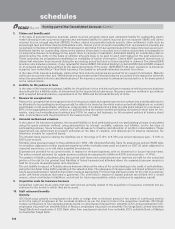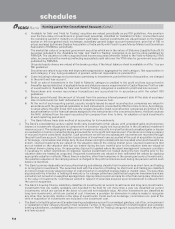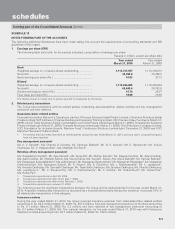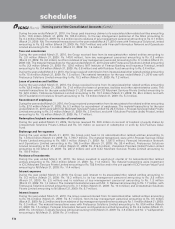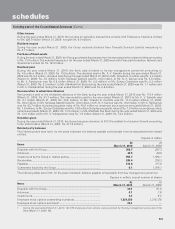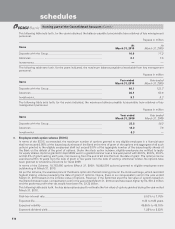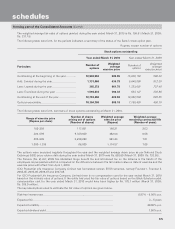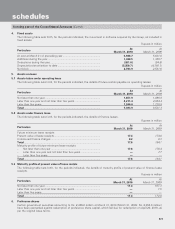ICICI Bank 2010 Annual Report Download - page 150
Download and view the complete annual report
Please find page 150 of the 2010 ICICI Bank annual report below. You can navigate through the pages in the report by either clicking on the pages listed below, or by using the keyword search tool below to find specific information within the annual report.
F70
schedules
forming part of the Consolidated Accounts (Contd.)
15. Transfer and servicing of assets
The Bank transfers commercial and consumer loans through securitisation transactions. The transferred loans are de-
recognised and gains/losses are accounted for only if the Bank surrenders the rights to benefits specified in the underlying
securitised loan contract. Recourse and servicing obligations are accounted for net of provisions.
In accordance with the RBI guidelines for securitisation of standard assets, with effect from February 1, 2006, the Bank
accounts for any loss arising from securitisation immediately at the time of sale and the profit/premium arising from
securitisation is amortised over the life of the securities issued or to be issued by the special purpose vehicle to which the
assets are sold. In the case of loans sold to an asset reconstruction company the gain, the excess provision, if any, is not
reversed but will be utilised to meet the shortfall/loss on account of sale of other financial assets to asset reconstruction
company.
16. Fixed assets and depreciation
Premises and other fixed assets are carried at cost less accumulated depreciation. Cost includes freight, duties, taxes and
incidental expenses related to the acquisition and installation of the asset. Depreciation is charged over the estimated useful
life of a fixed asset on a straight-line basis, the rates of depreciation for fixed assets are not lower than the rates prescribed
in Schedule XIV of the Companies Act, 1956.
Depreciation on leased assets and leasehold improvements is recognised on a straight-line basis using rates determined
with reference to the primary period of lease or rates specified in Schedule XIV of the Companies Act, 1956, whichever is
higher.
Assets purchased/sold during the period are depreciated on a pro-rata basis for the actual number of days the asset has
been put to use.
In case of the Bank, items costing up to Rs. 5,000/- are depreciated fully over a period of 12 months from the date of
purchase.
In case of revalued/impaired assets, depreciation is provided over the remaining useful life of the assets with reference to
revised assets values.
In case of the Bank’s life insurance subsidiary, intangible assets comprising software are stated at cost less amortisation.
Significant improvements to software are capitalised over the remaining useful life of original software. Software expenses,
that are capitalised, are amortised on straight-line method over a period of four years from the date they are put to use,
being management’s estimate of the useful life of such intangibles. Depreciation on furniture and fixtures is charged at the
rate of 15% per annum.
In case of the Bank’s general insurance and housing finance subsidiaries, computer software is stated at cost less amortisation.
Computer software including improvements is amortised over a period of five years, being management’s estimate of the
useful life of such intangibles.
17. Accounting for derivative contracts
The Group enters into derivative contracts such as foreign currency options, interest rate and currency swaps, credit default
swaps and cross currency interest rate swaps.
The swap contracts entered into to hedge on-balance sheet assets and liabilities are structured such that they bear an
opposite and offsetting impact with the underlying on-balance sheet items. The impact of such derivative instruments is
correlated with the movement of underlying assets and accounted pursuant to the principles of hedge accounting. Hedge
swaps are accounted for on an accrual basis except in the case of the Bank’s United Kingdom and Canadian banking
subsidiaries, where the hedging transactions and the hedged items (for the risks being hedged) are measured at fair value
with changes recognised in the profit and loss account.
Foreign currency and rupee derivative contracts entered into for trading purposes are marked to market and the resulting gain/
loss, (net of provisions, if any) is accounted for in the profit and loss account. Pursuant to RBI guidelines, any receivables under
derivative contracts, which remain overdue for more than 90 days, are reversed through the profit and loss account.
18. Impairment of assets
Fixed assets are reviewed for impairment whenever events or changes in circumstances indicate that the carrying amount of
an asset may not be recoverable. Recoverability of assets to be held and used is measured by a comparison of the carrying
amount of an asset with future net discounted cash flows expected to be generated by the asset. If such assets are
considered to be impaired, the impairment is recognised by debiting the profit and loss account and is measured as the
amount by which the carrying amount of the assets exceeds the fair value of the assets.
19. Lease transactions
Lease payments for assets taken on operating lease are recognised as an expense in the profit and loss account over the
lease term.
20. Earnings per share (EPS)
Basic and diluted earnings per share are computed in accordance with AS 20 on ‘earnings per share’ issued by ICAI.
Basic EPS is calculated by dividing the net profit or loss after tax for the year attributable to equity shareholders by the
weighted average number of equity shares outstanding during the year.
Diluted earnings per share reflect the potential dilution that could occur if contracts to issue equity shares were exercised
or converted during the year. Diluted earnings per equity share is computed using the weighted average number of equity
shares and dilutive potential equity shares issued by the group outstanding during the year, except where the results are
anti-dilutive.



